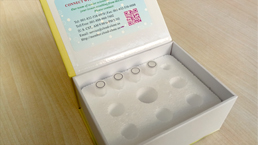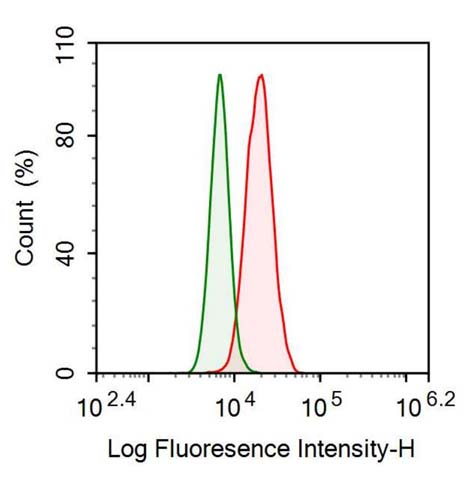Recombinant Antibody to Tau Protein (MAPT) 

DDPAC; FTDP-17; MAPTL; MSTD; MTBT1; MTBT2; PPND; Neurofibrillary tangle protein; Microtubule Associated Protein Tau; Paired helical filament-tau; G Protein Beta1/Gamma2 Subunit-Interacting Factor 1
- UOM
- FOB US$ 171.00 US$ 399.00 US$ 570.00 US$ 1,425.00 US$ 5,700.00
- Quantity
Overview
Properties
- Product No.RAB983Hu21
- Organism SpeciesHomo sapiens (Human) Same name, Different species.
- ApplicationsWB; IF; ICC; IHC; IP; FCM.
If the antibody is used in flow cytometry, please check FCM antibodies.
Research use only - Downloadn/a
- CategoryMetabolic pathwayNeuro scienceDevelopmental science
- SourceRecombinant monoclonal antibody preparation, Host Mouse
- Ig Isotype mouse IgG2b Kappa, Clone Number n/a
- PurificationProtein A + Protein G affinity chromatography
- LabelNone
- Immunogen n/a
- Buffer Formulation0.01M PBS, pH7.4, containing 0.05% Proclin-300, 50% glycerol.
- TraitsLiquid, Concentration 1mg/mL
Sign into your account
Share a new citation as an author
Upload your experimental result
Review

Contact us
Please fill in the blank.
Specifity
The antibody is a mouse monoclonal antibody raised against MAPT. It has been selected for its ability to recognize MAPT in immunohistochemical staining and western blotting.
Usage
Western blotting: 0.2-2μg/mL;
Immunohistochemistry: 5-20μg/mL;
Immunocytochemistry: 5-20μg/mL;
Flow cytometry:10μg/ml;
Optimal working dilutions must be determined by end user.
Storage
Store at 4°C for frequent use. Stored at -20°C in a manual defrost freezer for two year without detectable loss of activity. Avoid repeated freeze-thaw cycles.
Stability
The thermal stability is described by the loss rate. The loss rate was determined by accelerated thermal degradation test, that is, incubate the protein at 37°C for 48h, and no obvious degradation and precipitation were observed. The loss rate is less than 5% within the expiration date under appropriate storage condition.
Giveaways
Increment services
-
 Antibody Labeling Customized Service
Antibody Labeling Customized Service
-
 Protein A/G Purification Column
Protein A/G Purification Column
-
 Staining Solution for Cells and Tissue
Staining Solution for Cells and Tissue
-
 Positive Control for Antibody
Positive Control for Antibody
-
 Tissue/Sections Customized Service
Tissue/Sections Customized Service
-
 Phosphorylated Antibody Customized Service
Phosphorylated Antibody Customized Service
-
 Western Blot (WB) Experiment Service
Western Blot (WB) Experiment Service
-
 Immunohistochemistry (IHC) Experiment Service
Immunohistochemistry (IHC) Experiment Service
-
 Immunocytochemistry (ICC) Experiment Service
Immunocytochemistry (ICC) Experiment Service
-
 Flow Cytometry (FCM) Experiment Service
Flow Cytometry (FCM) Experiment Service
-
 Immunoprecipitation (IP) Experiment Service
Immunoprecipitation (IP) Experiment Service
-
 Immunofluorescence (IF) Experiment Service
Immunofluorescence (IF) Experiment Service
-
 Buffer
Buffer
-
 DAB Chromogen Kit
DAB Chromogen Kit
-
 SABC Kit
SABC Kit
-
 Long-arm Biotin Labeling Kit
Long-arm Biotin Labeling Kit
-
 Mouse Antibody Variable Region Gene Amplification Kit
Mouse Antibody Variable Region Gene Amplification Kit
-
 Real Time PCR Experimental Service
Real Time PCR Experimental Service
Citations
- Effect of etanercept and lithium chloride on preventing secondary tissue damage in rats with experimental diffuse severe brain injuryPubmed:24452937
- Wpływ omdlenia u młodocianych na stężenie białka tau w surowicy krwib09f7df8-1e7d-4665-a2a5-bf54dae0cfe9
- Serum microtubule associated protein tau and myelin basic protein as the potential markers of brain ischaemia-reperfusion injury in patients undergoing carotid endarterectomyAA.2016.0008
- THE PRESENCE OF TAU PROTEIN IN BLOOD AS A POTENTIAL PROGNOSTIC FACTOR IN STROKE PATIENTSpubmed:28011949
- Serum microtubule associated protein tau and myelin basic protein as the potential markers of brain ischaemia-reperfusion injury in patients undergoing carotid endarterectomyAA.2016.0008
- Differential hyperphosphorylation of tau-S199,-T231 and-S396 in organotypic brain slices of Alzheimer mice. A model to study early tau hyperphosphorylation using …Pubmed:29725295
- The potential role of serum tau protein (MAPT), neuronal cell adhesion molecule (NrCAM) and neprilysin (NEP) in neurodegenerative disorders development in …






